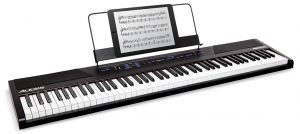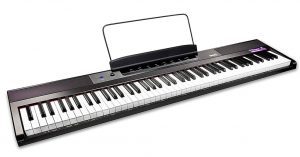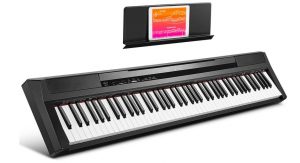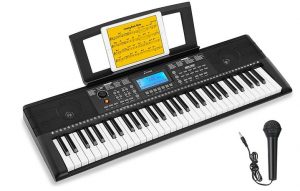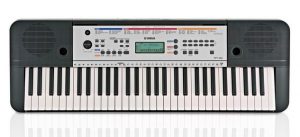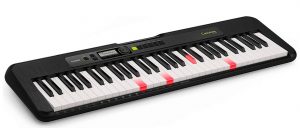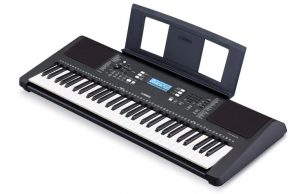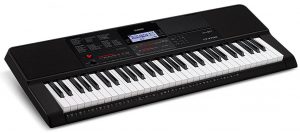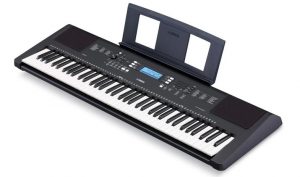Are you passionate about music, who has found your newfound interest in playing the piano? Or do you have a kid who is so much interested in taking up piano lessons? Then you should be looking for a decent piano with all features to help sustain the music interest without incurring a lot of money. Do you know? It is now possible to find a truly professional and high-quality professional piano at a minimal cost. In this article, we will see that we can purchase the best quality keyboards under $300. Though these are entry-level pianos, they are great for learning and practicing beginner piano lessons.
Quick Summary: Best Keyboards Under $300
Top 9 Best Keyboards Under $300
We have carefully picked the top 9 best keyboards under $300 from the leading piano manufacturing brands and described them in detail here with their intricate features.
#1. Alesis Recital Portable Keyboard – Best Overall
The best one in the category of best keyboards under $300 is Alesis Recital Portable Keyboard. The Alesis recital is an excellent digital electric piano with semi-weighted keys, speakers along with 5 premium voices. The Alesis recital is indeed an expert digital piano that is been tailor-defined to the needs of the players. This piano is a feature-packed electric keyboard that has 88- premium full-sized and semi-weighed keys with adjusting touch response.
This keyboard is capable of suiting one’s preferred playing style and has five premium sounds that include the electric piano, acoustic piano, synth, organ, and bass. The piano also features a built-in FC with chorus and reverb along with two built-in speakers that deliver crystal clear sound that could fill the room.
The piano has the best connections which include a ¼” sustain pedal, ¼” stereo headphones, and stereo RCA outputs to connect with the amplifiers and the speakers.
This piano is powered by a power adapter and 6D cell batteries for professional piano performance on the go. The piano has also powerful educational features and is divided into a split, a layer, a standard, and a lesson mode. The piano also features a 128-note max polyphony and a three-month subscription to Skoove for interactive piano lessons.
Pros
- The piano includes interactive piano lessons and 60 free virtual lessons.
- The recital fuses 88-full sized weighted keys, 5 premium voices, reverb, chorus notes
- The output from this piano is great with sublime sound and a natural playing experience.
- Players love its adjusting metronome and its innovative lesson mode.
Cons
- The sustain pedal has to be bought separately.
- The advanced settings of this piano are a bit confusing.
Also check: Best Beginner Digital Pianos & Keyboards 2021
#2. Rockjam RJ88DP 88-Key Digital Piano – Runner Up
| Features | Rating |
| Performance and sounds | 9.1 |
| Connectivity | 9.1 |
| Build Quality | 9.1 |
| For Beginners | 9.3 |
| Value for money | 9.2 |
The next one in the category of best keyboards under $300 is Rockjam RJ88DP. The Rockjam 88-digital piano keyboard features 88 full-size semi-weighted piano keys that are velocity-sensitive and are capable of replicating the feel of the real piano. This weighted piano is packed with several modern features that include ten unique voices that correspond to the electric piano, grand piano, synth, bass, percussion, guitar, etc. This electric keyboard features inbuilt stereo speakers that are capable of delivering a powerful 24 Watts sound.
The piano has a headphone input so that the players can practice in privacy without having to disturb others. Also, the keyboard has weighted keys that includes a USB input to play along with one’s favorite songs. The inputs on these keyboards include a ¼ inch sustain pedal input, ¼-inch soft-pedals input, 7-pin sostenuto pedal input, and a ¼ inch microphone connector. The simple piano application can be accessed instantly on both iOS and Android devices to assist in playing piano for beginners.
Pros
- Keynote stickers are available for the piano keyboard to render a visual indication of the right keys.
- This 88-key digital piano has two inbuilt 24-watt speakers that are semi-weighted, full-sized, and velocity-sensitive.
- There are 8 external connections in this digital piano.
- Its electric keyboard that 8 different tones, 20 voices, sensitivity controls, lesson mode, and a minimal touch screen panel.
Cons
- There is no LCD screen included with this piano.
- The music stand is not very appealing.
#3. Donner DEP-10 Digital Piano – Editor’s Choice
| Features | Rating |
| Performance and sounds | 9.4 |
| Connectivity | 9.1 |
| Build Quality | 9.1 |
| For Beginners | 9.6 |
| Value for money | 9.4 |
This is an expert beginner digital piano with 88 keys. This is a full-size semi-weighted portable keyboard with a sustained pedal and power supply. The piano features 88-half weighted hammer keys that are capable of stimulating the real touch of playing the piano. Its half-weighted keys help in a more sensitive touch response to suit different playing styles. This piano is thus best suited for beginner piano players and features 8 excellent voices and 128 polyphony. It is possible to arise the sounds of a church organ, grand piano, and acoustic piano from this unit, and with its 128 polyphony, users could easily distinguish the tones in both chorus and reverb under different occasions.
Its multifunctional settings help in controlling rhythm through the metronome, controlling effects, and meeting the diverse needs of different types of music players. The sustain pedal, audio input, and performance for the players. The piano features a streamlined body and textured keys, rendering an extraordinary playing experience for piano players, helping them to play the best music.
Pros
- This is perfect for both teaching and learning functions.
- This is an 88-key standard piano that restores the touch of traditional pianos.
- Features a high-quality zinc alloy sustain pedal.
- Features 128 polyphony and premium tones with half-weighted hammer keys.
- It is one of the best in the category of best keyboards under $300.
Cons
- The piano doesn’t come with a stand.
#4. Donner EDK-610 Keyboard Piano – Popular Choice
| Features | Rating |
| Performance and sounds | 9.3 |
| Connectivity | 9.2 |
| Build Quality | 9.1 |
| For Beginners | 9.5 |
| Value for money | 9.3 |
This is an excellent beginner electronic piano with 61- keys. The piano comes with a music stand, keyboard stand, stool, and microphone. As this piano features three teaching modes, it is suitable for beginners. This electric piano has a small and fine footprint and is very lightweight as well. It features a three-dimensional surround sound, a dual keyboard, and 61 full-size keys. This electronic keyboard features about 500 tines, 40 demo songs, and 300 rhythms. This piano is more like a huge music library and it is thus possible to conduct an entire band show with this keyboard.
The keyboard has an LCD zone that displays the functions that are been used in this keyboard. The screen is also able to offer feedback on the diverse built-in teaching functions of this piano. The piano has a USB midi interface to meet the needs of the music players. There is also a pedal interface, two audio interfaces, and connections with the earphone, microphone, and MP3 player.
Pros
- Having this piano at home replaces a piano teacher.
- The piano features innovative chord modes.
- Features a dual power supply mode to play music on the move.
- The piano has stereo sound speakers to make a soft and perfect sound.
Cons
- Perfect piano only for beginners and novice players.
- Features only 61 piano keys.
Also check: Best Digital Pianos Under $700 to Buy in 2021
#5. Yamaha YPT-260 Keyboard – Great Performance
| Features | Rating |
| Performance and sounds | 9.6 |
| Connectivity | 8.9 |
| Build Quality | 8.8 |
| For Beginners | 9.7 |
| Value for money | 9.5 |
This piano comes as a perfect piano bundle to start playing just out of the box. The piano comes with a keyboard, stand, bench, and power supply. It has more than 400 voices, 130 auto accompaniments, and playing styles and backing tracks along with more than a hundred onboard songs.
The best feature of this piano is its education suite with 9 step lesson function. Its Aux input allows the players to play the music along from a phone, computer, or tablet device. Its recording functions help players to record and playback at the same time.
This instrument is capable of replicating the sounds of an acoustic piano and helps players to create high-quality music with its auto-accompaniment styles.
The piano has a duo mode to help two people play on the same instrument at the same time, by creating two middle C notes. Its compact and lightweight design allows players to take the instrument with them wherever they go. Its battery power ensures that we can set up the piano at any place, without having to plug it in.
Pros
- There is a three-step lesson mode with listening, timing, and waiting modes available for the hands to learn piano lessons.
- It is possible to play along with your favorite songs on the piano.
- The USB-to-host terminal helps to play high-quality audio without the need for any additional interface.
Cons
- Relatively Small keyboard.
- Appeals more to beginner keyboard players.
#6. Casio LK-S250 61-key Premium Keyboard – Good Alternative
| Features | Rating |
| Performance and sounds | 9.3 |
| Connectivity | 9.2 |
| Build Quality | 9.1 |
| For Beginners | 9.4 |
| Value for money | 9.3 |
This is an excellent lighted keyboard with a stand and headphones. It features 61 full-size tough responsive light-up keys along with 400 great-sounding tones and 77 fun rhythms. The dance music mode of this piano helps to easily create and remix EDM tracks. Players can use the USB- MIDI, AC adapter, and optional battery power to operate this piano. It also connects with the Chordana Play app to learn piano lessons easily.
This piano is available at an affordable cost and features 61 full-size touch-responsive keys, 60 built-in songs, and a voice-guided lesson system. Music players can explore about 400 great music tones, 77 accompaniment rhythms, and more than ten types of reverbs to add more depth to the music. The dance music mode feature of this keyboard helps players to easily create and remix EDM tracks and use the piano keys to play and trigger drum loops, synth parts, basslines, effects, transitions, and a lot more.
Pros
- Its class-compliant USB port connects with any PC, Mac, iOS, and Android device without any drivers.
- The Samson HP30 playback headphone offers great sound.
- The piano features a lightweight, closed-back design with an adjusting headband.
Cons
- The piano is very small
- The keys are hard to press.
Also check: Best Digital Pianos for Learning in 2021
#7. Yamaha PSRE373 Portable Keyboard – Great Choice
| Features | Rating |
| Performance and sounds | 9.6 |
| Connectivity | 8.8 |
| Build Quality | 8.9 |
| For Beginners | 9.5 |
| Value for money | 9.5 |
This is an excellent touch-sensitive portable keyboard that is ideal for hobbyists and beginners. The smart chord feature of this piano allows the players to play great-sounding chords from simple pop triads to complex jazz chords with just a single finger. Its smart chord features help in playing the chords easily for beginners. Its built-in voice and style is been inspired by cultures all over the world, which helps players to play virtually any kind of music. The touch-sensitive keys on this piano help with expressive dynamic music controls.
The piano is packed with over 622 stunning sound voices and a wealth of many music accompaniment styles. This piano also features more than eleven super articulation lite voices and is inherited from the powerful PSR-S models. The piano also offers real-time and expressive music from different string instruments, adding more realism to the music. Its smart chord feature allows playing great-sounding music from simple pop triads to complex jazz chords within a few fingers.
Pros
- This is a touch-sensitive keyboard that renders an excellent array of high-quality music.
- Features a comprehensive library of 622 instrument voices, that is perfect for playing high-quality music in any genre.
- Possible to add a lot of effects to the playing styles.
Cons
- The power adapter for this piano is sold separately.
- The piano doesn’t come with a power adapter.
#8. Casio CT-X700 PPK Premium Keyboard – Another Alternative
| Features | Rating |
| Performance and sounds | 9.3 |
| Connectivity | 9.2 |
| Build Quality | 9 |
| For Beginners | 9.4 |
| Value for money | 9.4 |
This is a premium keyboard that comes as a bundle with a power supply, stand, and headphones. It is packed with more than 600 tones and there is a lifelike instrument to explore in each of these tones. The piano features hundredths of built-in rhythms, playing with realistic instruments, that sound best than ever. The piano also has a library of 100 built-in songs, a six-track recorder, and a step-up lesson system. This lesson system can be used to learn the songs easily and also teach proper fingering techniques and notations.
Its class-compliant USB-MIDI port connects with any MAC, PC, or Android drive without requiring any drivers and installation. The piano also features a music rest that could adopt support tables and a built-in smartphone shelf to hold the device. Above all these features, this piano is portable and lightweight and features a tough molded plastic case with optional battery power thus music players can port it to any place and play high-quality music.
Pros
- Features more than 600 times with an incredible variety of instruments.
- Has hundredths of built-in rhythms to play some popular music.
- Its music rest is capable of supporting a range of devices.
Cons
- The LCD screen is not intuitive.
- Its power plug is bulky.
#9. Yamaha PSR-EW310 76 Key Portable Keyboard – Value for Money
| Features | Rating |
| Performance and sounds | 9.4 |
| Connectivity | 9.1 |
| Build Quality | 9.1 |
| For Beginners | 9.5 |
| Value for money | 9.5 |
The Yamaha PSR-EW310 is an excellent starter keyboard that has everything that a beginner piano player requires. This piano has 76 keys and appeals to both beginner and professional piano players. Its advanced wave memory sampling engine is capable of recreating the realism of an acoustic instrument, thus reproducing its dynamic nuances and recording the samples of different playing strengths.
Its smart chord feature allows the players to play some great-sounding chords from simple pop triads to complex jazz, within a few finger touches. Its super articulation lite voices can be controlled with the help of the ‘art’ button to intuitively reproduce the natural expressive tones of other non-keyboard instruments. This piano allows players to achieve realistic expressions in real-time and to play some high-quality music. Its super articulation lite voices feature is capable of reproducing unique nuances of high-quality music.
Pros
- The piano features touch-sensitive keys for expressive and dynamic control.
- Its digital signal processor allows the players to add a lot of studio-quality effects to the music.
- Its smart chord feature helps to play some lush-sounding chords with just one finger.
- It also features a backlit LCD to change the settings ambiently.
Cons
- This keyboard doesn’t come with a USB cord
- The piano keys are not weighted.
Also check: Top 15 Best Digital Pianos in the Market
Most Popular Piano Brand. Why?
The most well-known and esteemed piano manufacturer in the world is undoubtedly Steinway & Sons. The master craftsman at Steinway & Sons spends almost a year building each piano, which has more than 12,000 pieces. At the ripe old age of 20, Heinrich Engelhard Steinway of Sessen, Germany, started building pianos in his home. Heinrich made the decision to emigrate to America 25 years after constructing his “kitchen” piano and 482 instruments later. In 1853, the now-famous Henry E. Steinway and his family established Steinway & Sons in New York, which is perhaps the most well-known of our piano manufacturers.
127 patents have been awarded to Steinway & Sons, who are regarded as the inventors of the modern piano. The Steinway & Sons piano is praised by 1700 professional pianists, and many other musical institutions also use them. In addition to having a plant in Hamburg, Steinway & Sons continues to construct pianos in New York. The company manufactures upright and grand pianos in addition to two bespoke collections dubbed Crown jewels and Custom for customers looking for a truly distinctive piece.
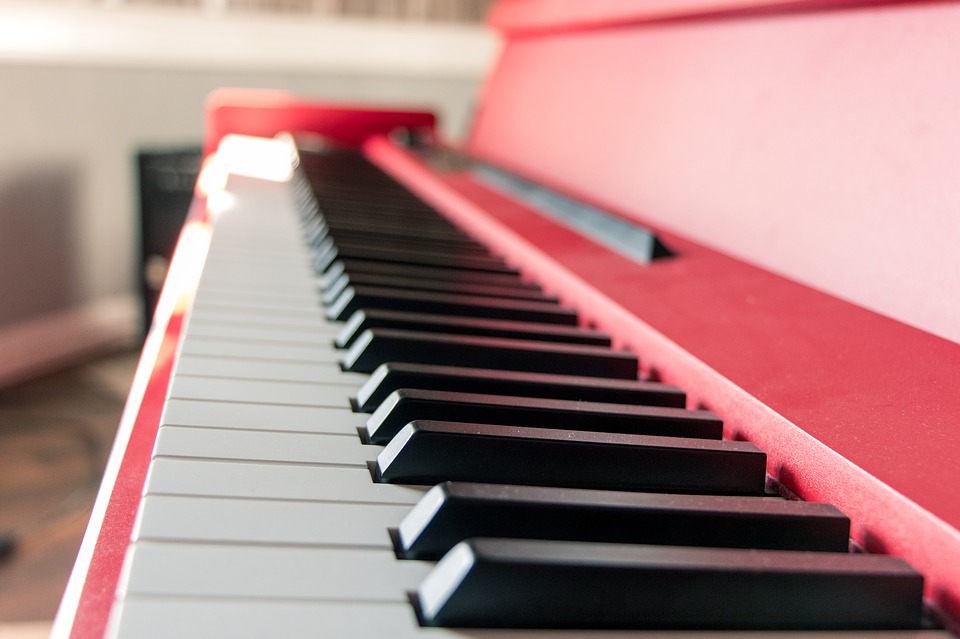
For the excellence of their pianos, Steinways & Sons have won recognition from New York, Paris, and numerous other organizations. This does imply that their pianos really aren’t inexpensive, but the good news is that the company also produces two more reasonably priced brands, Essex and Boston if you can’t afford a Steinway & Sons. Boston is intended for the mid-level market, whereas Essex targets the entry-level market for Steinway.
Because of Theodore Steinway’s technical expertise, the expanding business was in capable hands. Being preferred by top pianists over rival pianos was regarded as being extremely prestigious and influential. This led to the creation of the Steinway Artists program and the company’s collection of performance instruments. The market for pianos today is far smaller than it was during the ‘ Golden Age ‘ of the industry. This is not to imply that there isn’t still a lot of competition.
Steinway & Sons, Yamaha, and Kawai appear to be the main rivals in this musical arms race. Makers engage in fierce competition for the endorsements of artists. (Recently, Yamaha was able to obtain Ben Folds’ endorsement while Steinway was able to lure Bruce Hornsby away from Baldwin.
The good news is that each remaining company is striving for perfection as a result of the ongoing competition. The choice of a concert piano is primarily driven by personal desire because most nine-foot pianos from the major manufacturers are of quite similar quality. Even while Steinway & Sons pianos, both new and vintage, continue to rule the concert stage, it’s wonderful that other manufacturers are still in a competitive position. The ongoing competition makes sure that both performers and collectors can have the best pianos.
Also check: Best Budget Digital Pianos Under $500
Classical Piano vs 61 Key Piano
Though keyboards normally contain 88 keys, pianos and grand pianos may have more or fewer keys depending on the player’s preferences and playing style. The need for 76 and 61-key instruments is also high in addition to 88-key keyboards. The 61-key keyboards’ widespread use is largely attributed to their convenient use, professional features, and small size.
Professional musicians love the versatility of the tiny 61-key keyboard, and this is one of the main factors they consider when purchasing an instrument. Keyboardists value an instrument that is lightweight, portable, and simple to carry whether they are playing it at home or on tour, in the practice space, or in front of an audience.
Piano players don’t lose out on the performance range or functionality of the 76 or 88-key keyboards even if the keyboards only go up and down four and a half octaves. Touch dynamics on a 61-key keyboard provide an actual stage piano sensation.
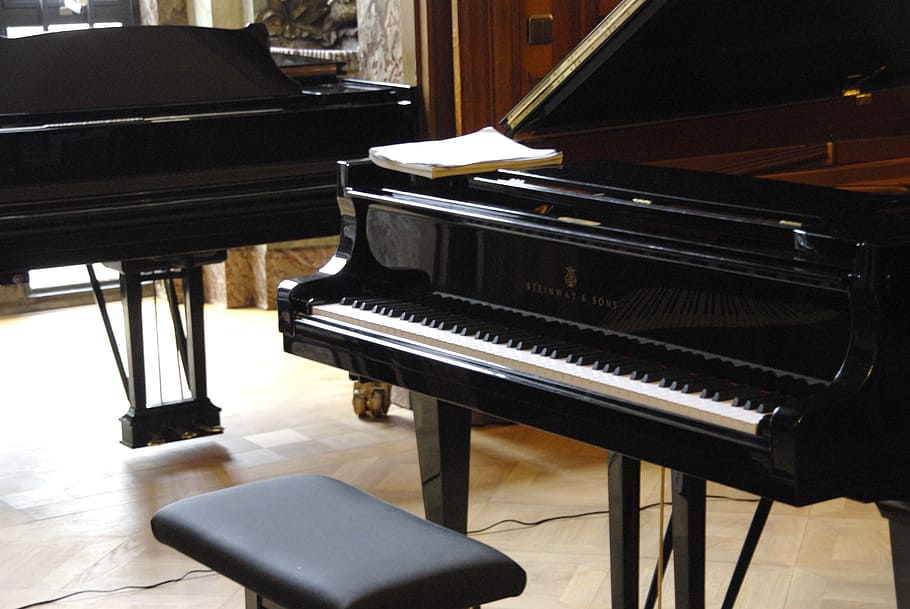
While 61-key keyboards are frequently classified as entry-level keyboards, pros also favor these keyboards. The 61-keyboard series is the ideal place to start if you want to learn how to play the piano and become familiar with a keyboard instrument but feel overwhelmed by a digital piano or an 88-key classic keyboard. This vast collection features 36 white & 25 black velocity-sensitive piano-style keys with a range of four and a half octaves, giving the playing experience a genuine sense.
You gain a very solid foundation in piano technique by studying classical music. The only method to hear music before the invention of audio recording was to see a live performance. This meant that a lot of music was created for education or for amateur musicians. The framework, compositional methods, technical demands, and harmonies in this music were brief and straightforward.
A wonderful method to improve your piano and compositional skills is to study classical music. When it comes to teaching agility and quickness and enabling students to play challenging pieces, the classical piano technique is unmatched. Because they’re able to read sheet music, those who have been taught classical technique have practically mastered a second language.
Average Budget To Set While Buying A Piano.
You can choose between a new and a used piano depending on your degree of ability and other preferences. Better performance and sound quality, greater control over upkeep and maintenance, and a warranty are all benefits of buying a new piano. You may expect to pay between $2,000 and $9,000 for a new digital piano, between $55,000 and $150,000 for a grand piano, and between $10,000 and $50,000 for an upright piano.
A more costly piano will have parts made of better-quality materials. The soundboard of the majority of high-end pianos is made of softwoods like spruce and cedar. Because they can transfer sound and bear pressure, certain kinds of wood are perfect for the soundboard. Cheaper pianos use hardwoods like birch and oak for the outside casting while more expensive pianos use materials like maple and rosewood.
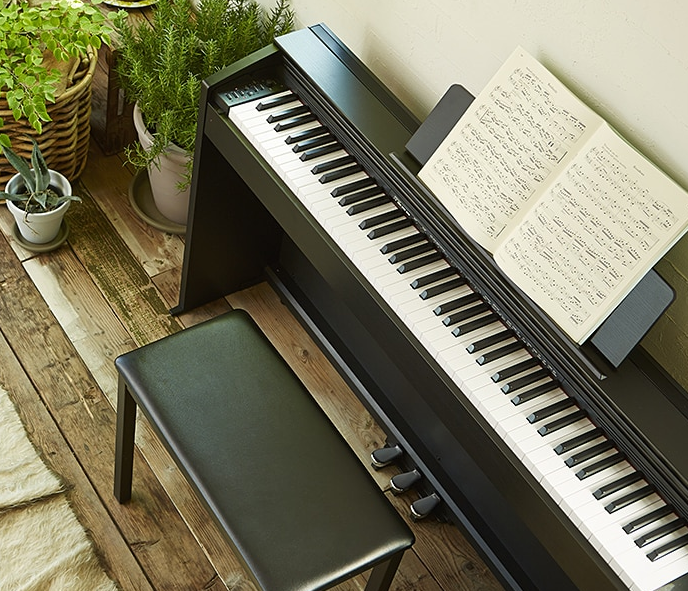
It’s crucial to keep in mind that buying a piano includes certain unanticipated expenditures, just as with other major purchases. Some of them consist of:
1. Moving Fees: A piano that has been improperly moved will be harmed. Even though the majority of vendors include transportation fees, some might not, particularly second-hand dealers.
2. Accessories: Extras like the music stand and piano bench might be purchased separately.
3. Maintenance: This also applies to acoustic pianos, which occasionally should be tuned or fixed.
It might be wise to get a less expensive piano and then set aside some of the money for various piano-related costs if some of the hidden prices are out of your price range. In the end, you should first choose the piano kind that best meets your requirements. Then you’ll be able to decide how much money you’re willing to pay.
Piano Accessories You Must Have.
- No matter who is performing on the piano, adjustable benches or a rise-and-fall bench allow you to adjust the elevation of the stool to the ideal position. These are excellent for beginning musicians or even if you have several musicians in your home who share one instrument.
- We strongly advise staying away from earbuds. As handy as they are when traveling, they aren’t big enough to perfectly represent the piano’s wide frequency range, and they aren’t particularly the most relaxing either. Therefore, for those reasons, it is advised to purchase a pair of over-ear headphones. Any pair of studio headphones should work in this situation.
- Stage pianos and portable keyboards frequently include rudimentary sustain pedals that, while they may function, aren’t the most sensitive. If you have the option, we always advise replacing a basic sustain pedal with a more robust model.
- You’ll need a stand to put your piano on if we’re talking about stage pianos or keyboards right now. We advise using a double-braced X-frame stand because stage pianos typically have 88 notes and weighted keys.
- All pianos come with an installed music rest; however, they can be a bit small and make it challenging to place many pieces of music as well as bulky books on them. So, it would be wise to choose a reliable music stand.
- Having said that, there is a tonne of books available that cover the subject of piano, and occasionally there is no alternative for a good tuition book. You may discover a book for everyone, covering everything from the fundamentals of music theory to general playing style, classical concertos, and well-known Disney tunes.
- A metronome is an essential tool for piano instruction. Since the pendulum style of the past, these ticking boxes have advanced significantly and are now more sophisticated than ever.
Bottom Line
The niche of affordable and high-quality pianos has always been popular among piano enthusiasts. There are several beginner keyboards that are available for less than $300 and we have sorted the best of them here so that you can have your hands on the best keyboards under $300.
Frequently Asked Questions (FAQs)
1. Is It Advised to Buy Second-Hand Pianos?
The chance of a distinctive sound, lower pricing, and slower depreciation rates are some benefits of purchasing a used piano. Despite the fact that they may look attractive, vintage pianos do not age well. This is particularly true if a piano hasn’t had the necessary maintenance.
2. What is a Trans Acoustic Piano?
The Trans Acoustic piano uses a soundboard to naturally augment the digital tones with Trans Acoustic Technology, making it a true acoustic piano. With the aid of digital sounds, this technology helps acoustic elements come to life.
3. What is a Hybrid Piano?
The acoustic touch of hybrid pianos is combined with the impact of digital pianos. In light of this, hybrid pianos are essentially digital pianos with authentic piano movement, giving players the impression that they are playing a traditional acoustic-style piano.
4. How Superior is the Quality of Steinway And Sons Pianos?
With their renowned concert pianos, Steinway & Sons have raised the bar on the concert stage and will continue to do so. There is little doubt that their pianos’ high quality has allowed them to keep their position of dominance. Many people believe that the Steinway Model D is the ideal concert grand piano.
5. Why is Steinway & Sons’ D model So Popular?
To ensure that both the quality of their instruments and their market share continued to increase, Steinway & Sons waged an almost merciless war on the commercial front. As a result, the Steinway Model D has come to represent the concept of a concert piano. They have been featured in documentaries, articles, and news reports for their exquisite workmanship.


